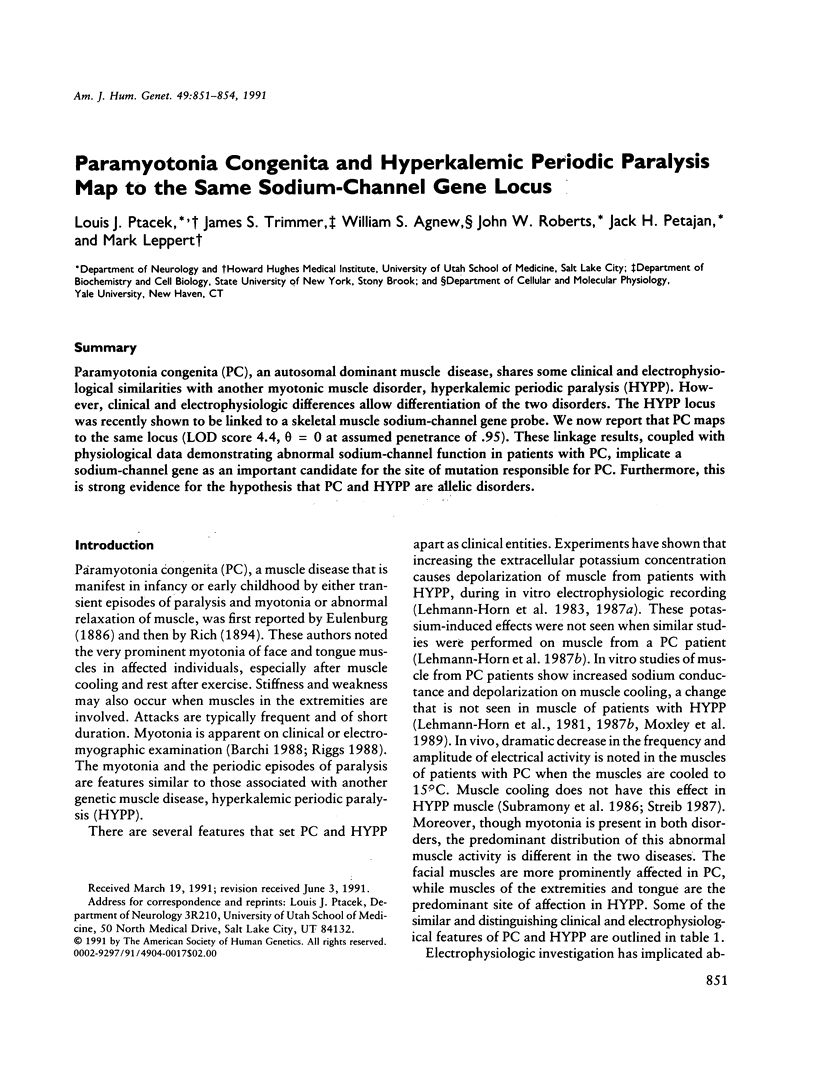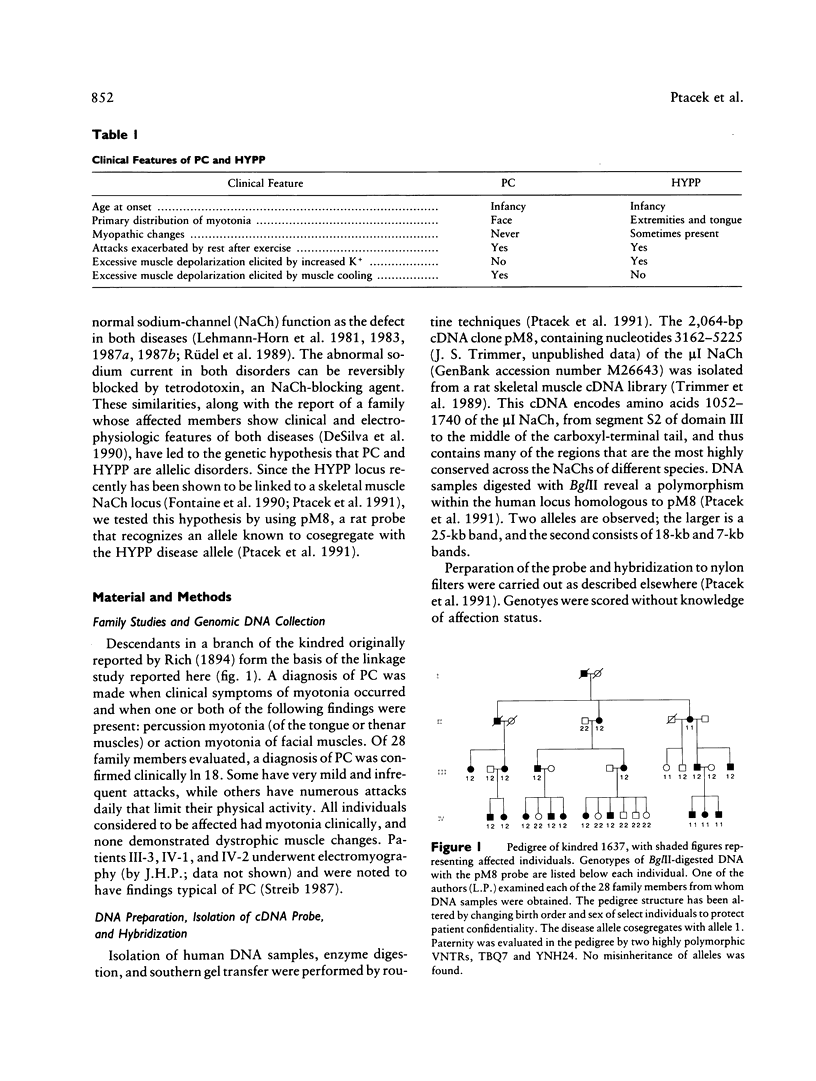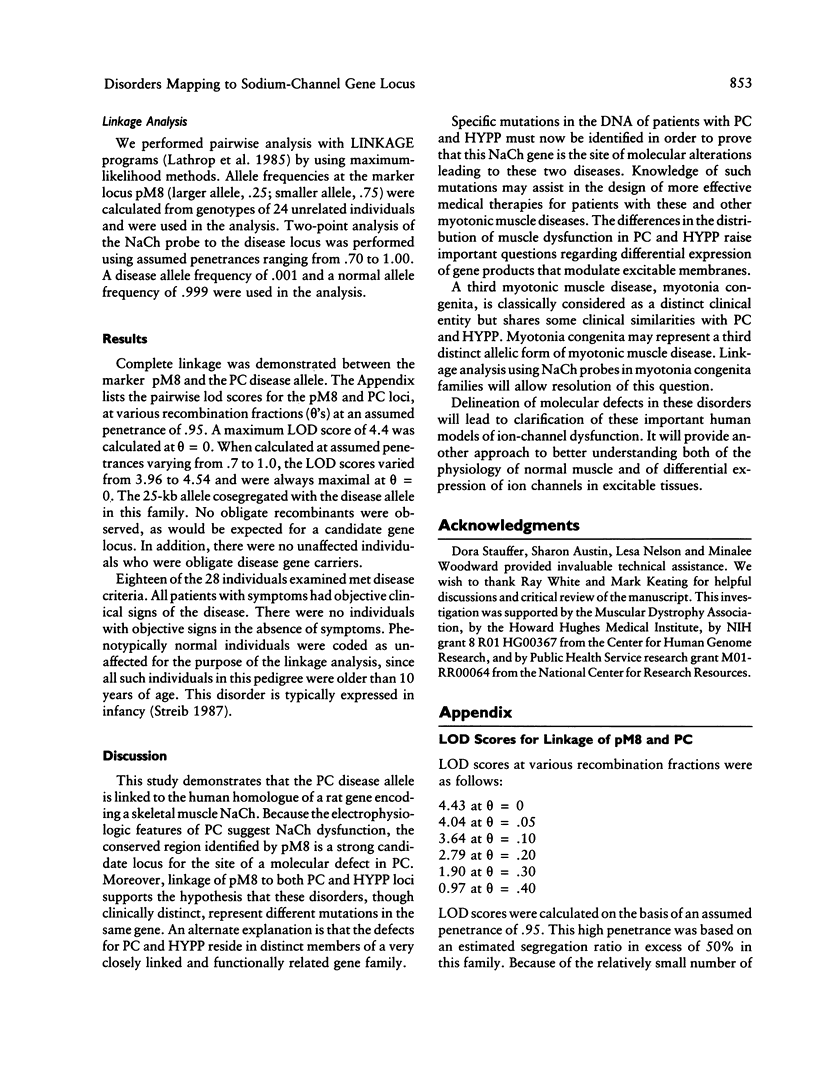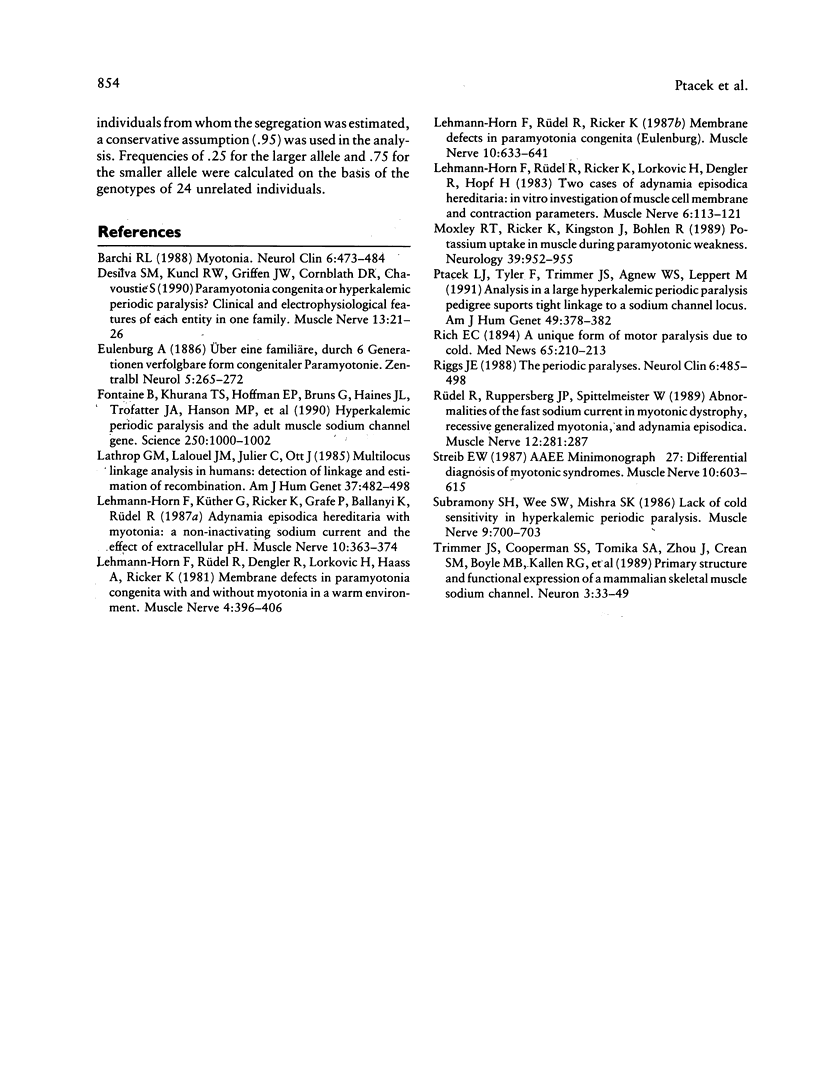Abstract
Paramyotonia congenita (PC), an autosomal dominant muscle disease, shares some clinical and electrophysiological similarities with another myotonic muscle disorder, hyperkalemic periodic paralysis (HYPP). However, clinical and electrophysiologic differences allow differentiation of the two disorders. The HYPP locus was recently shown to be linked to a skeletal muscle sodium-channel gene probe. We now report that PC maps to the same locus (LOD score 4.4, theta = 0 at assumed penetrance of .95). These linkage results, coupled with physiological data demonstrating abnormal sodium-channel function in patients with PC, implicate a sodium-channel gene as an important candidate for the site of mutation responsible for PC. Furthermore, this is strong evidence for the hypothesis that PC and HYPP are allelic disorders.
Full text
PDF



Selected References
These references are in PubMed. This may not be the complete list of references from this article.
- Barchi R. L. Myotonia. Neurol Clin. 1988 Aug;6(3):473–484. [PubMed] [Google Scholar]
- Fontaine B., Khurana T. S., Hoffman E. P., Bruns G. A., Haines J. L., Trofatter J. A., Hanson M. P., Rich J., McFarlane H., Yasek D. M. Hyperkalemic periodic paralysis and the adult muscle sodium channel alpha-subunit gene. Science. 1990 Nov 16;250(4983):1000–1002. doi: 10.1126/science.2173143. [DOI] [PubMed] [Google Scholar]
- Lathrop G. M., Lalouel J. M., Julier C., Ott J. Multilocus linkage analysis in humans: detection of linkage and estimation of recombination. Am J Hum Genet. 1985 May;37(3):482–498. [PMC free article] [PubMed] [Google Scholar]
- Lehmann-Horn F., Küther G., Ricker K., Grafe P., Ballanyi K., Rüdel R. Adynamia episodica hereditaria with myotonia: a non-inactivating sodium current and the effect of extracellular pH. Muscle Nerve. 1987 May;10(4):363–374. doi: 10.1002/mus.880100414. [DOI] [PubMed] [Google Scholar]
- Lehmann-Horn F., Rüdel R., Dengler R., Lorković H., Haass A., Ricker K. Membrane defects in paramyotonia congenita with and without myotonia in a warm environment. Muscle Nerve. 1981 Sep-Oct;4(5):396–406. doi: 10.1002/mus.880040508. [DOI] [PubMed] [Google Scholar]
- Lehmann-Horn F., Rüdel R., Ricker K., Lorković H., Dengler R., Hopf H. C. Two cases of adynamia episodica hereditaria: in vitro investigation of muscle cell membrane and contraction parameters. Muscle Nerve. 1983 Feb;6(2):113–121. doi: 10.1002/mus.880060206. [DOI] [PubMed] [Google Scholar]
- Lehmann-Horn F., Rüdel R., Ricker K. Membrane defects in paramyotonia congenita (Eulenburg). Muscle Nerve. 1987 Sep;10(7):633–641. doi: 10.1002/mus.880100709. [DOI] [PubMed] [Google Scholar]
- Moxley R. T., 3rd, Ricker K., Kingston W. J., Böhlen R. Potassium uptake in muscle during paramyotonic weakness. Neurology. 1989 Jul;39(7):952–955. doi: 10.1212/wnl.39.7.952. [DOI] [PubMed] [Google Scholar]
- Ptacek L. J., Tyler F., Trimmer J. S., Agnew W. S., Leppert M. Analysis in a large hyperkalemic periodic paralysis pedigree supports tight linkage to a sodium channel locus. Am J Hum Genet. 1991 Aug;49(2):378–382. [PMC free article] [PubMed] [Google Scholar]
- Riggs J. E. The periodic paralyses. Neurol Clin. 1988 Aug;6(3):485–498. [PubMed] [Google Scholar]
- Rüdel R., Ruppersberg J. P., Spittelmeister W. Abnormalities of the fast sodium current in myotonic dystrophy, recessive generalized myotonia, and adynamia episodica. Muscle Nerve. 1989 Apr;12(4):281–287. doi: 10.1002/mus.880120405. [DOI] [PubMed] [Google Scholar]
- Streib E. W. AAEE minimonograph #27: differential diagnosis of myotonic syndromes. Muscle Nerve. 1987 Sep;10(7):603–615. doi: 10.1002/mus.880100704. [DOI] [PubMed] [Google Scholar]
- Subramony S. H., Wee A. S., Mishra S. K. Lack of cold sensitivity in hyperkalemic periodic paralysis. Muscle Nerve. 1986 Oct;9(8):700–703. doi: 10.1002/mus.880090804. [DOI] [PubMed] [Google Scholar]
- Trimmer J. S., Cooperman S. S., Tomiko S. A., Zhou J. Y., Crean S. M., Boyle M. B., Kallen R. G., Sheng Z. H., Barchi R. L., Sigworth F. J. Primary structure and functional expression of a mammalian skeletal muscle sodium channel. Neuron. 1989 Jul;3(1):33–49. doi: 10.1016/0896-6273(89)90113-x. [DOI] [PubMed] [Google Scholar]
- de Silva S. M., Kuncl R. W., Griffin J. W., Cornblath D. R., Chavoustie S. Paramyotonia congenita or hyperkalemic periodic paralysis? Clinical and electrophysiological features of each entity in one family. Muscle Nerve. 1990 Jan;13(1):21–26. doi: 10.1002/mus.880130106. [DOI] [PubMed] [Google Scholar]


